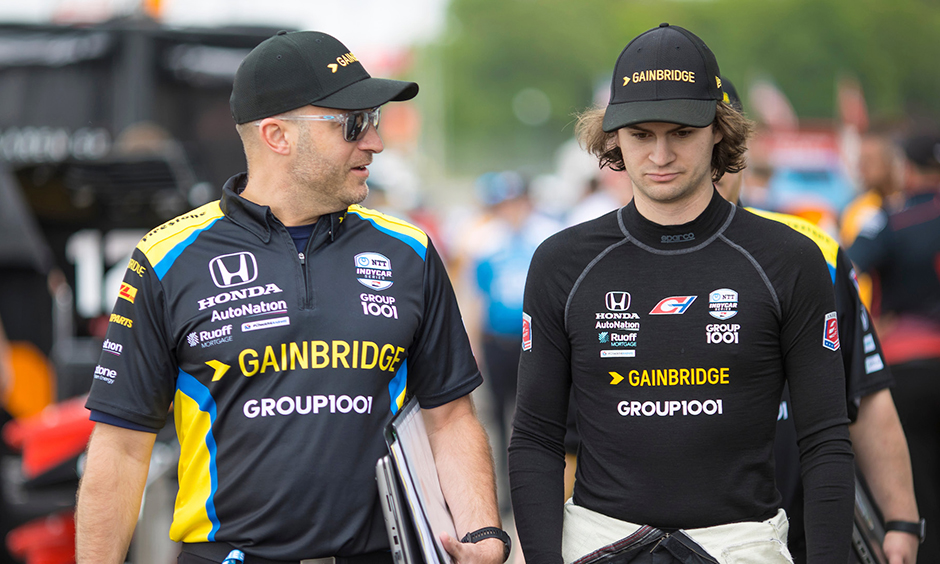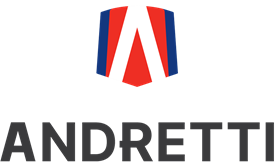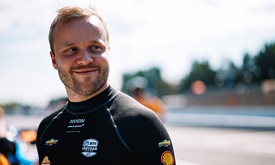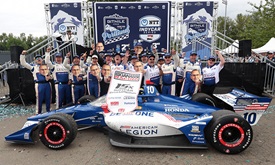The Setup: Laguna Seca with Nathan O’Rourke
SEP 05, 2023
Note: This is a continuing series for INDYCAR.com with different guests leading into each race weekend for the NTT INDYCAR SERIES, focusing on various technical challenges of each respective circuit.
The 17th and final round of the 2023 NTT INDYCAR SERIES season takes place at WeatherTech Raceway Laguna Seca for this weekend’s Firestone Grand Prix of Monterey.
The 11-turn, 2.258-mile permanent road course first hosted an INDYCAR SERIES race in 1983, although the track opened in 1957. There are seven left turns and four right turns. Track width varies from 30 feet to 78 feet.
The three-day event features two practice sessions and an NTT P1 Award qualifying bout ahead of Sunday’s 95-lap (214.51 miles) race at 3 p.m. ET (NBC, Peacock, INDYCAR Radio Network).
The single-lap qualifying record is held by Helio Castroneves, who posted a time of 1 minute, 7.722 seconds while driving for Team Penske in 2000. This week’s featured guest is Nathan O’Rourke, the race engineer for Colton Herta’s No. 26 Gainbridge Honda of Andretti Autosport w/Curb-Agajanian. Herta has two of the past three races and a pair of NTT P1 Award poles at this track.
Q: What are the characteristics of WeatherTech Raceway that make it unique? Obviously, there are new variables with the repaving, which makes for something of an unknown. How do you prepare?
O’Rourke: I know this segment is called The Setup, but everywhere we go the cars are close enough to being a spec car that most of the time the driver is the real secret. And I think that I have to give Colton all the credit for that. I think that's just a place that really suits his driving style, and that’s why he is consistently fast there. There are some tracks where every driver likes a certain type of balance in the car. They like the car to do certain things to suit the way they like to drive it. Some places you can do that, and you can make them happy and they're not fast. And some places you can give them what they want, and they can be fast.
I think all those pieces kind of fit well together with him at Laguna. It's the right type of track, like the way the corners flow that you can give him that type of balance that he likes and he's comfortable with and you know that you're going to be quick. I think a lot of people have made it a topic that his dad was successful there and he passed along some tips, and I'm sure a little bit of it that's true. But I think those two have driven far enough apart with different cars and the tracks changed a little bit to where there's probably not much of that that still applies. So, you’ve got to give Colton the credit for figuring that out. And, you know, he did that right from the word go. When we went there in his rookie year, he was quick.
Something people probably don't remember is there was a test that year where everybody in the series went except him, and then he showed up and was quick, maybe quickest every session. So, that alone was impressive. But yeah, it is a pretty unique track. Like you said, the surface this year is going to be a huge change for that. The old surface was extremely abrasive; it had been around for a really long time. So, what you can get away with for a couple laps was a lot different than what you could get away with for a whole race. I think he saw that last year, like with Alex Palou in particular, what he was so good at last year was degradation.
Last year, Palou was on the three-stop strategy but had the pace of the guys who were doing the four-stopper. So, he kind of figured out a way to do the best of both worlds. He’s continued that strength into this year, which has, in our opinion, been what's made him so impressive. And what we're trying to figure out is, how is he so good on tire degradation? But you know, I think with the new surface that that's going to reset it a little bit. Like I said, the old surface is very worn. There's a lot of exposed aggregate.
The cars as they drive over some of these paving jobs the last 20-plus years, they just continually wear over the same bit of track and it pulls away a lot of the smaller aggregate and filler out of the paving job, and you get those big, almost like rocks, and what it looks like is exposed aggregate, which really wears away the tires. It’s a lot like Sonoma. I think that’s all going to go away now so what I expect is a much darker surface, which probably means higher track temperatures, but it should be smoother. So, that might move us into a sense where we're more concerned about thermal degradation of the tires rather than just from being hot and going faster than what we get from what I would tend to call a wear degradation of the tire.
Q: It almost sounds like when you're talking about the thermal aspect of it. Does that mean you’re having to change the approach of how the energy of the tire wears compared to where it is at most tracks?
O’Rourke: To some extent, yeah. When you get a paving job, I certainly expect once we get some rubber down there, the lap times are going to increase. So, the faster you go around a corner the more energy the tire has to produce to keep the car stuck to the track. So, even we might be sliding around less, but when you slide a tire, it wears and generates heat. You’ve got to think about that. If you have a 2,000-pound car going around a 3G corner, those 2,000 pounds actually turn into 6,000 pounds. With every increment in speed, the more work the tire’s having to do.
I guess it's more of a way of saying the tire's having to do work in a different way. How is that going to impact our setups? We had a similar experience at Road America this year where we had a new surface, and it certainly did change our balance and we certainly did have to adapt to setups. It ended up being quicker, and I'd say our degradation was better. We were just going quicker. So, if I had to predict, that's what is going to happen at Laguna. I would say we’re probably going to have much better tire degradation, less drop-off, and it'll probably be going quicker.
Q: Road America was exactly the place I was thinking of when we started talking about resurfacing, and I’m sure it’s a benefit that you’ve had a track earlier in the schedule that has been resurfaced. You alluded to there being a lot of common factors.
O’Rourke: I think so. What might be different is how the balance of the car shifts. You know, are you going to pick up more understeer or oversteer with the same setup with the surface change? I don't think we can accurately predict that until we go there and do it. Hopefully it's not that much. But definitely Elkhart Lake did take a setup change, and we were able to adapt to it pretty quickly. In terms of our performance, I'm bullish about Laguna for several reasons. One, if you could pick out one factor the obvious one is that Colton is extremely competitive there. The next one would be we've been really good at getting our tires to come in quickly and being quick over a couple laps.
But again, and I think we've gotten to the point where our degradation is much better than what it used to be, and we understand why that is and we have a much better handle on that now than what we did I would say earlier in the season. But fully admit that we haven't figured out how to have the type of degradation that the 10 car (Alex Palou) has, so maybe it’s a bit lucky for us that they've repaved the track. I hope we're able to use all of our strengths, right? Like, we were able to get the tires in quickly, but degradation is not as much of a concern. Couple that with Colton's skill level, and I think we have reasons to be excited about the weekend. Remember, Colton was on pole at Elkhart Lake and was in a position to win the race on the new surface, so hopefully that carries over.
Q: Laguna Seca is a place where drivers use the curbs quite a bit. Have they changed the curbing or just the surface? I think about how that changes the ride heights.
O’Rourke: As far as ride heights, I’ll use Elkhart Lake as an example. We went into that race with that same logic where it's a smooth track. We're probably going to be able to run the car a lot lower. But because it was so much faster, we ended up higher with the ride height just because in a lot of sections of the track we were bottoming. We were going so much faster that we had to get the car off the ground. The other issue you run into on smooth tracks sometimes versus bumpy tracks is it’s difficult for the driver to know when he’s bottoming too much because the track is so smooth. Whereas on a bumpy track it, he can feel it a lot more. He’ll know he’s bothering things because he’s slamming the bumps. Whereas on a smooth track, because it's so smooth, the bottom of the car slowly approaches the ground and almost kisses itself into the ground like a plane making a nice smooth landing. So, the drivers might not even feel it and that has a (negative) effect like putting the brakes on.
If you're bottoming too much, it slows you down and you don't want that. I think about our bottoming limits a lot there. Being fast corners, like Turns 6, 9 and 10, we’re not at a place like Elkhart Lake, but you’re bottoming at the end of the straightaway because that's where your max speed is. But at Laguna those corners are, you’re so close to your top speed anyway in those corners that you get what we call roll bottoming where like Turn 10, in particular, and in Turn 9, you're going so fast that you have bottoming from going fast but then you kind of roll. Let’s say you go into Turn 9, which is a left-hander, then the right side of the car starts dragging the ground. Then you go through Turn 10, and the left side starts dragging the ground. You get a similar thing at Mid-Ohio in Turn 1, so that’s what you’re watching for there.
On that note, I almost suspect that with Laguna with the speeds likely to increase a lot in those corners that we're probably going to end up with the car higher. As far as the bumps are concerned, there weren't really many there. You typically clip some curbs at the apex of Turn 6 and the exit there, and you ran over the curbs at the exit of 11. So, if anything, you had to build into your setup to help make that better. I don't know if they’ve changed the curbs that much. At Elkhart Lake, they basically ripped up all the road but left the same apex and exit rumble strips and curves. We’re going to have to take a look at that when we get there. Typically, when bumps go away and traction gets better, you typically tend to run the car stiffer, but it doesn’t always mean it’s the right thing to do. I imagine most teams probably won’t just go there with a way stiffer car because it got repaved. You want to go there with a setup, whether it’s an old Laguna Seca setup or maybe we put on our Mid-Ohio setup or something that’s known so you can try to assess how the track’s changed before you pre-emptively react too much.
Q: What’s the trickiest part of a Laguna Seca setup?
O’Rourke: The compromise between the low-speed corners and the high-speed corners and just trying to balance the mechanical and aero grip balance. That’s why one of the things that makes Laguna Seca cool is the elevation there. But we really don’t have an elevation setup, so to speak. We don’t really change what we’re doing in that respect. But certainly in the past, there were huge compromises to be made between getting good traction out of Turn 11 and (compromising) to make the car stable through the fast corners. You could make the assumption that the traction’s going to be way better this year because the track surface is new, but it might not be. Yeah, the Corkscrew is a neat corner, for sure, but I’d say what is required there is somewhere in between what is required at the low-speed and high-speed corners. We aren’t doing anything special. Again, this is more about the compromises you make between the slow corners like Turn 11 and the high-speed corners like 6, 9 and 10.
Q: What is the challenge of trying to get the car balance right for qualifying versus the balance for the full stint in the race?
O’Rourke: I think that’s pretty significant challenge everywhere we race. I don't know if it is the tires changing or tracks weathering over time, but tire degradation has become much more of a factor at some tracks. Now, it’s honestly something we're talking about at all tracks. There was a time where at street courses we didn't have to worry about tires falling off, and now it's one of the things we talk about most. Now we have to make a definite shift in mindset when it comes to driving and setting up the car between what you’re able to get away with for qualifying for a couple laps versus making the tires last over a full stint.
To be candid, that’s been our (team) weakness. There have been pieces we've been able to qualify well, but then we've moved backward in the race because we didn't have as good enough degradation as some of the other cars. So that's really been a focus for all of our entries, honestly, over the second half of the year. We’re really just trying to understand what that is. And I really think we've made a lot of progress on that. So, but to answer your question, yeah, there is a definite shift – a huge shift – in mindset. You need to understand that on a race stint you might need to give up a little bit of lap time in the first few laps in order to make sure you're not suffering too much at the end.
Q: You have worked with Colton for quite a while now, and you’ve watched him grow into the driver he is today. He’s gone from being a raw talent to a crafty professional. But what makes him so good at Laguna Seca?
O’Rourke: I don’t want to give away the secrets about the way he likes to drive, but it’s like what I said earlier, it’s one of those places where the way he likes to drive the car and the way he likes to have the balance in the car, it's a track where you can be very fast with that type of approach. There have been plenty of drivers, and he’s had a lot of teammates driving at this track during the time period you brought up, right? They’ve tried to drive Colton's preferred setup and have not been able to be quick with it. Those same people were able to be quicker at Laguna Seca by going to something different. So, sometimes even for Colton it's difficult for a driver to understand what setup changes they need to go quicker.
A lot of times drivers, even the best of them, will think they need something to go quicker, and they actually don't like the thing that bothers them the most. Maybe that’s the thing that's going to make them go quicker. Laguna Seca has been a place where Colton has had a very clear understanding of what he wants the car to do, and he's been correct in his prediction of knowing what he needs and if you give it to me, I’ll go quicker. And if I'm smart enough to figure out how to make the car do that, he's going to go quicker. And you know, even from when he was 19 years old and there for the first time, he was right.



















